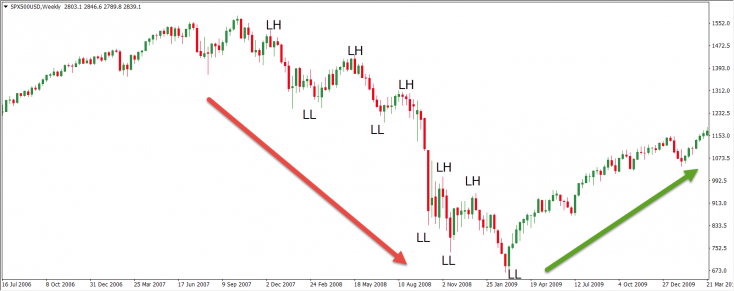Trading Basics
Bear Market
A Bear Market occurs when the price of a security is falling, and the negative outlook of the security causes the security’s price to continue to fall, causing a self-sustaining problem.
For a downturn like this to be officially considered a bear market, it must be on-going for longer than two months, otherwise it is known as a correction.
Bears are generally traders with a pessimistic view on markets that look to profit from a decline in prices.
- Learn more, take our premium course: Trading for Beginners
What is a Bear Market?
Financial markets often use expressions from the animal world to describe the current state of a particular market.
For example, when referring to the rising prices of cryptocurrencies in 2017, traders and investors often talked about bull markets, while the stock market fall during the 2007-08 financial crisis carried the etiquette of a bear market in financial media.
Why are investors using bulls and bears to describe the phenomenon of rising and falling prices?
There’s a simple explanation – think about the way how these animals attack their prey. Bulls thrust their horns up into their opponent, while bears use their paws to overthrow their prey.
Bull markets go up, bear markets go down – makes sense, right?
What Does a Bear Market Mean?
Now that you know how bear markets got their name, let’s see how the trading activity looks like during a bear market. Bear markets are characterised by falling prices during a period of time, usually over months or even years.
When prices fall, many investors are locking their profits from short-sell activities, and buyers who consider the prices as too low are jumping into the market again, forming a market correction or bear market rally. A market correction is a price movement that goes against an established bull or bear market, which in the case of bear markets is a short-term rise of prices.

While deteriorating investor confidence leads to falling stock prices, buyers enter the market when prices are considered too low, lifting the prices and forming lower highs (LHs). However, as the overall market sentiment is bearish, higher prices attract sellers who push the stock prices down again. This market psychology forms the characteristic zig-zag patterns in the charts.
Read: How Market Psychology Works (and how to take advantage of it)
This chart shows the S&P 500’s bearish trend during 2007-2008. Other market indices, such as the Dow Jones Industrial Average (DJIA) that tracks the 30 largest US companies by market cap, showed a similar price pattern in that period. Bears and bulls alternately change forces, forming lower lows and lower highs, with bears having the upper hand in the downtrend.
Check Out:
How to Profit in a Bear Market
Even when prices drop during a market crash, there still exist profitable trading opportunities on Wall Street. The good news is, financial advisors and investors believe that you don’t have to lose money in the stock market during a bear market.
Even a 20 percent drop in prices may be a good time to start buying again.
As Warren Buffett once said, “Be fearful when others are greedy and greedy only when others are fearful.”
This strategy is popular not only among stock traders – fixed income and bond investors can also benefit from it when bond yields start to fall, signalling a recover in the bond market.
Read:
- What is a Junk Bond?
- 31 Motivational Trader Quotes You Can Live By
- These Winning Forex Strategies Will Blow You Away
Another popular way to trade bear markets is to short-sell a trading instrument.
When asset prices start to fall and the downtrend shows signs of continuation, traders can borrow the instrument and sell it at the current (higher) price.
- Learn more, take our free course: Continuation Price Patterns
After the price drops, traders buy the instrument at the lower price and return it to their lender.
This trading practice is called short-selling, and you should check with your broker what instruments you’re able to short-sell.
In addition, you can allocate your investments among different asset classes during a downtrend.
Here’s what to invest in a bear market:
- If a bear stock market forms, look for investment opportunities in the bond market or Forex. Similarly, a bear bond market sees investors fleeing to other markets, such as the stock market for example.
- In times of a large financial crisis, safe havens such as the Japanese yen, Swiss franc, gold and treasury bonds, have a tendency to rise.
What is a Bear Market Trap?
A bear market trap forms during a bull market when market participants start to anticipate an end to the uptrend and increase their bearish positions, only to see the prices rising again. Bear market traps are false signals that the uptrend is about to reverse. Since bear markets form lower lows and lower highs, look for these price patterns first to confirm a downtrend and to avoid a bear trap.
Other Trading Basics
Asian Session
When the majority of Asian markets are open and trade.
Typically 23:00 to 08:00 GMT.
Bank of England
The UK’s central bank responsible for setting interest rates for Sterling and maintaining stability in the UK’s financial industry.
Start learning now
Learn the skills needed to trade the markets on our Trading for Beginners course.
